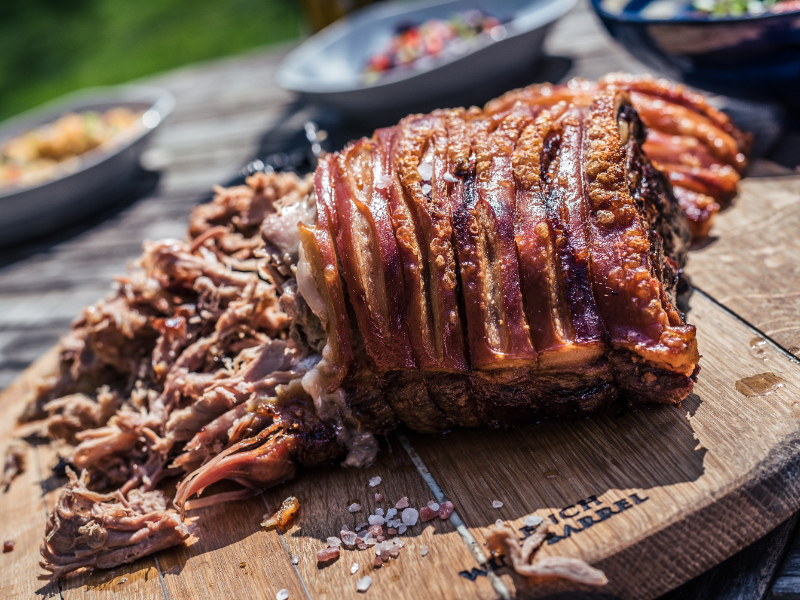Everyone loves to have a barbeque party with friends, grab a beer, and enjoy a perfectly tender and smoky pulled pork. But what should you do when the weather outside is not in favor of firing up the grill? Luckily there is an option for how you can achieve nearly the same results from the comfort of your home. Let’s prepare your sous vide equipment and follow our guide, and you will end up with a fantastic BBQ pulled pork without stepping out of your kitchen.
Ingredients (8-10 servings):
- 5 lbs (2.2 kg) of whole boneless pork butt or shoulder
- 2 tablespoons (30 g) of paprika
- 2 tablespoons (30 g) of dark brown sugar
- 2 tablespoons (30 g) of kosher salt
- 1 tablespoon (15 g) of freshly ground black pepper
- 1 tablespoon (15 g) of garlic powder
- 1 tablespoon (15 g) of dried oregano
- 1 tablespoon (15 g) of ground mustard seeds
- 1 tablespoon (15 g) of ground coriander seeds
- 1 teaspoon (5 g) of red pepper flakes
- 1 tablespoon (15 g) of yellow mustard
- 1/2 teaspoon (2.5 ml) of liquid smoke
- 1/2 teaspoon (2.5 g) of pink salt (optional)
Steps:
- Selection of the Meat
- Getting Prepared for Cooking (Mise en Place)
- Cooking Sous Vide – Temperatures and Time
- Finishing the Meat and Serving Options
Step 1: Selection of the Meat
Let’s look at the first step in the process of perfect pulled pork – a proper selection of the meat. If you are not an experienced cook, you may find yourself a bit confused when standing in front of the meat counter, looking at all the different options of pork cuts. What are the main factors that ensure the highest quality of the results every single time?
Cuts of the Meat
There are lots of different types of cuts, but what is the best choice when looking for great pulled pork? The overall favorite is undisputedly a pork shoulder, especially the upper part called pork butt, even though it comes from behind the neck. This cut contains a fair amount of fat, which renders during the cooking and leaves the meat tender, juicy, and flavorful. Some people find it too fatty or do not like the bits of the connective tissue within. They will rather look for the pork loin, which is located right next to the shoulder and is much leaner. On a downside, it may become a bit dry using conventional cooking methods. That will not be a big concern for you thanks to sous vide, which keeps even those leaner cuts incredibly juicy.
Visual Appearance
After you selected an ideal cut for you, you may want to examine the quality of the meat itself, which can differ significantly. You are looking for intramuscular fat (marbling), which is always a good indicator of how well the animal was raised. You also do not want to see any excess liquid in the package, which may suggest that water had been added artificially. The meat should look dry, have a bright pink color (avoid any pale brown pieces), and all the visible fat should be completely white without any yellow specks.
Step 2: Getting Prepared for Cooking (Mise en Place)
To achieve great results, it is always necessary to get appropriately prepared so you can easily manage to go through each step without making any mistakes. Prepare all the dry spices and seasonings and mix them in a bowl. To achieve the same appearance as a regular BBQ meat, you may add a teaspoon of pink or curing salt to the mixture. By adding it, it helps to create the familiar smoke ring effect due to the same chemical reaction as during the smoking. Before you season your meat, it is always good to trim any excess fat, connective tissue, and especially silver skin which will not break down even after extended cooking. When the meat is cleaned, brush the surface with yellow mustard, which helps all the spices to adhere. Season the pork all around liberally with the mixture leaving no spot uncovered. Keep aside about 1/3 of the spice mix for later use. Place the meat into a large sealing bag. You may use two layers to be sure that it will not burst. To get the typical BBQ smokiness, you should add a teaspoon of liquid smoke right before you close or seal the bag. Be careful not to spill it all over the place, if you do not want your kitchen to smell like a fireplace. Everything should be ready by now, so you can move on cooking.
Step 3: Cooking Sous Vide – Temperature and Time
Now let’s examine the essential step in your sous vide cooking – how to set the optimal temperature and how long you should let your meat cooking. Below you can see the exact numbers and ranges for your pulled pork. You may also use your sous vide app if your device manufacturer provides one.
Extra juicy and suitable for slicing:
145 °F (63 °C) – 155 °F (68 °C) for 24 hours
Juicy and suitable for shredding:
165 °F (74 °C) for 24 hours
Note: These temperatures and timings apply for pulled pork only
Here you have two options that are dependent on your preference. But be prepared to wait at least 24 hours, until the meat is sufficiently cooked.
For the perfectly moist and tender meat that is not completely falling apart and can be easily sliced into thin strips, you would need to set the temperature relatively lower between 145 °F (63 °C) to 155 °F (68 °C). This method is more suitable for leaner cuts like pork loin.
For the typical pulled pork that falls apart, and you can shred it with a fork and still has a lot of moisture, the temperature needs to stay around 165 °F (74 °C). This method is more suitable for fattier cuts like pork shoulder/butt.
Step 4: Finishing the Meat and Serving Options
When the meat is ready, open the bag and carefully pour out all the collected juices to a pot. Place it on a stove and leave it to reduce on high heat until there is about 1/4 left. Pull out the pork from the bag into a deep baking tray so you do not lose any juices that may leak from the meat. Now you have two options on how to proceed.
Pull it apart right away
Shred the meat to bits of your linking in your banking tray and add the reduced juices. You may adjust the seasoning and serve immediately.
Let it crisp up in the oven
Preheat your oven to 300 °F (149 °C). Season your meat once again all around with the rest 1/3 of the spices you reserved. When the oven reaches the preset temperature, place the pork into a baking tray on a rack. That allows the air to flow around the meat so that the crust will form over all the surface. Let it roast in the oven for about 1 hour until it is entirely dark brown. This process will leave your pulled pork with a thick, crispy, and flavorful crust that everyone loves. After you have shredded the meat apart, add the reduced juices to restore the moisture that was lost during the roasting.


